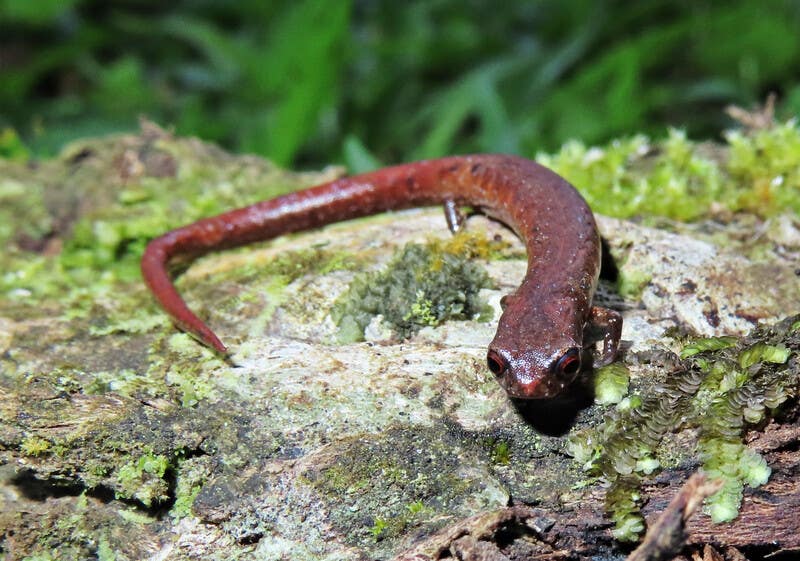At first glance, the headline from the second Global Amphibian Assessment may seem a bit doom and gloom: amphibians around the world continue to be in big trouble. They are, in fact, among the most threatened animals on the planet, with two out of every five species threatened with extinction. For those of you who haven’t committed any rent space in your brain to frogs, toads, salamanders and newts — those wiggly things that hop, squirm and slither — you might not think this is important to you.
But ask any herpetologist and they will back me up. The more you know about amphibians, the less you need to be convinced that they are the coolest--and that their health matters to the overall health of the planet and all life on it (including yours and mine!). From the mystifying regeneration of lost limbs, spines, hearts, and even brains, to breathing through toxic, kaleidoscopic skin, it’s no wonder their remarkable evolutionary innovations have put them at the center of everything from modern medical research to ancient myth and folklore. And within the planet’s intricate web of biodiversity, these metamorphic shapeshifters also serve as key indicators of ecosystem health, known to be some of the world’s best natural pest controllers.
The news for amphibians isn’t all bad. In Costa Rica, for example, two amphibian species—La Estrella Salamander (Nototriton picadoi) and Richard's Salamander (Nototriton richardi)—are bucking the downward trend for amphibians, thanks to an impressive suite of conservation actions put into motion decades ago by the country’s government. The two species are among 63 found by the second Global Amphibian Assessment to have improved in IUCN Red List status since 1980 as the direct result of conservation action.
“Salamanders are the most threatened group of amphibians on our planet, which makes these two improvements in Red List category an extraordinary victory,” says Kelsey Neam, Re:wild species priorities and metrics coordinator. “It’s these types of stories that provide shining examples of how effective habitat protection, policy changes and an investment in ecosystem restoration can reverse biodiversity loss.”
So how did Costa Rica flip the script for at least two of its amphibian species? It’s not only a story about the comeback of two salamanders. It’s a story that points to a society’s capacity to alter its collective behavior, to the complicated work behind large-scale change, and to the commitment of those driving a process bigger than themselves. It’s a story that began with entire rainforests disappearing from one season to the next and is still being written today within those same forests, now dense and teeming with sound and life.
From deforestation to revolutionary restoration
There is no better person to tell the story of Costa Rica’s reforestation transformation than former Minister of the Environment and Energy, and current CEO of the Global Environment Facility, Carlos Manuel Rodríguez.
Rodríguez’s journey into conservation wasn’t necessarily deliberate, but in the Costa Rica of his youth, it may have been unavoidable. Rodríguez tells me that the Costa Rica he grew up in was very different from the one we know today.
“You know, in most of Costa Rica in the 1980s, when I was in my 20s, you weren’t able to go to many places during the rainy season because the roads were so bad,” he says. “You could only go again a year after. So there were many times when I saw a forest, and the next dry season I went back to that same forest, and it was not there. Even though it was kind of common at the time and people accepted it, for me, I was very sad with what I saw. I never said to myself, ‘I will dedicate my life to saving the forest.’ But without any doubt, the forest burning and deforestation had an impact on me.”
Following the introduction of logging and the prioritization of land use for crops and livestock, Costa Rica experienced one of the highest rates of deforestation in the world. While its forests covered about 75% of the country in the 1940s, by the late 1980s this had declined to a startling 25% of the national territory.
Cut to today, and Costa Rica has restored an impressive 1.2 million hectares of its forested land.
Step One: arriving at the right framework
“There were three main elements that were the key reasons why Costa Rica was able to stop deforestation and restore degraded land,” Rodríguez says. “First, and very importantly, we went through a learn-by-doing process until we found the right institutional framework.”
In other words, Costa Rica reorganized some of its key government agencies. In 1986 the country made the decision to move its conservation agencies out of the Ministry of Agriculture, the institution driving deforestation, and into a newly founded Ministry of Environment, focused on the conservation of natural resources. Makes sense, right? Rodríguez thinks so too.
“If you have a country with a forest service in the Ministry of Agriculture, they will only see the forest as timber, as opposed to a forest in the Ministry of Environment, which will see the forest for biodiversity, environmental services, and people.”
If reorganizing existing government agencies and creating new ones sounds like it was a bit tricky, Rodríguez assures me that it certainly wasn’t easy. But it was just the beginning.
Step Two: Saying goodbye to harmful incentives
The second element of Costa Rica’s reforestation had to do with identifying and eliminating the harmful incentives and policies that promoted deforestation. Rodríguez shares that the road to change Costa Rica’s legislation was long and difficult, as it often is when it comes to lawmaking.
“‘Let’s get rid of the forest and fill the landscape with cows,’ that was the idea. We eventually learned the hard way that this was not a good idea. So it was here that we went through a very, very difficult period of changing laws and policies.”
During his mid-20s in law school, Rodríguez did the first research on mapping these “perverse incentives,” finding a total of 63 policies that were causing deforestation. For example, during the mid-20th century, land colonization laws encouraged citizens to clear forests for agricultural use, effectively promoting deforestation. These laws allowed individuals to claim ownership of public land if they cleared and cultivated it, contributing to significant forest loss. Policies favored cash crops and cattle ranching and even provided financial and technical support to farms and ranchers to promote these activities. And the government also offered tax incentives and credits to individuals and entities that converted forested land into agricultural land.
Over a period of about 10 years, Rodríguez and his colleagues worked to reverse most of these harmful policies and watched as, gradually, deforestation began to decline and restoration started to increase.
Step Three: Payments for Ecosystem Services
Rodríguez calls the “final” step “the cherry on top of the cake of the restoration process,” a program that has been bringing Costa Rica international attention, called Payments for Ecosystem Services (PES).
Introduced in 1996, PES was a new set of improved forest incentives offered to farmers or landowners in exchange for managing their land to provide some sort of ecological service. Simply put, after getting rid of the harmful incentives, they created new incentives that supported restoration and conservation. Rodríguez explains the impacts of PES.
“Back then for Costa Ricans, we saw deforestation as development, prosperity, and growth,” he says.” Whenever you had a farm full of cows or coffee, that was beautiful. But if you had a farm full of forest, it was not seen as something positive. Today, people can log their forests, but they don’t want to. If you have a forest and you keep it, the market gives you a clear indication that there will be money through tourism and through PES, that will be higher than the benefit of cutting the trees. So people are not cutting the trees.”
A salamander success story
For Juan Abarca and Valeria Aspinall, herpetologists at the Costa Rica Wildlife Foundation, the positive downstream effects of all these systemic conservation efforts are just beginning to be seen.
Along with increased research efforts and the inspiring commitment of Costa Rican citizens–some of whom have even discovered and described new amphibian species–scientists have been seeing a broader impact on species from Costa Rica’s conservation strategies, including for the La Estrella Salamander and Richard's Salamander.
“Of course, when people protected these areas in the ‘80s, they weren’t imagining they’d be protecting endangered species,” Abarca says. “This was not the urgent priority at the time. It was just about protecting the land. They weren’t thinking about salamanders. But the effects of those conservation years of creating national parks, wildlife reserves, PES, are reflected today in what we are finding at this moment.”
Today, Costa Rica has managed to double the size of its forest territory, while making advancements in education level and poverty reduction during the same time frame. Its PES program has created 18,000 jobs, with the country’s number one source of jobs being nature-based tourism.
“Costa Rica’s 40-year-long process to reverse deforestation has clearly meant powerful benefits for both the wildlife and people who live here,” Neam says. “When we conduct the third Global Amphibian Assessment, we hope that we will continue to see Costa Rica’s threatened amphibian species move away from extinction.”
Laura Moreno is a writer and communications specialist from the world of ocean conservation, working to share the stories that drive the protection and restoration of the wild. She is passionate about elevating the voices that inspire us from the front lines of conservation and exploring the species that remind us of the magic of what’s worth protecting.
When she’s not writing or looking at photos of nudibranchs, she spends her time surfing between one of two west coasts, California and Portugal, and digging for hidden sonic gems in record shops. Laura loves finding the right words, sounds, movements and music that make good stories come alive.




